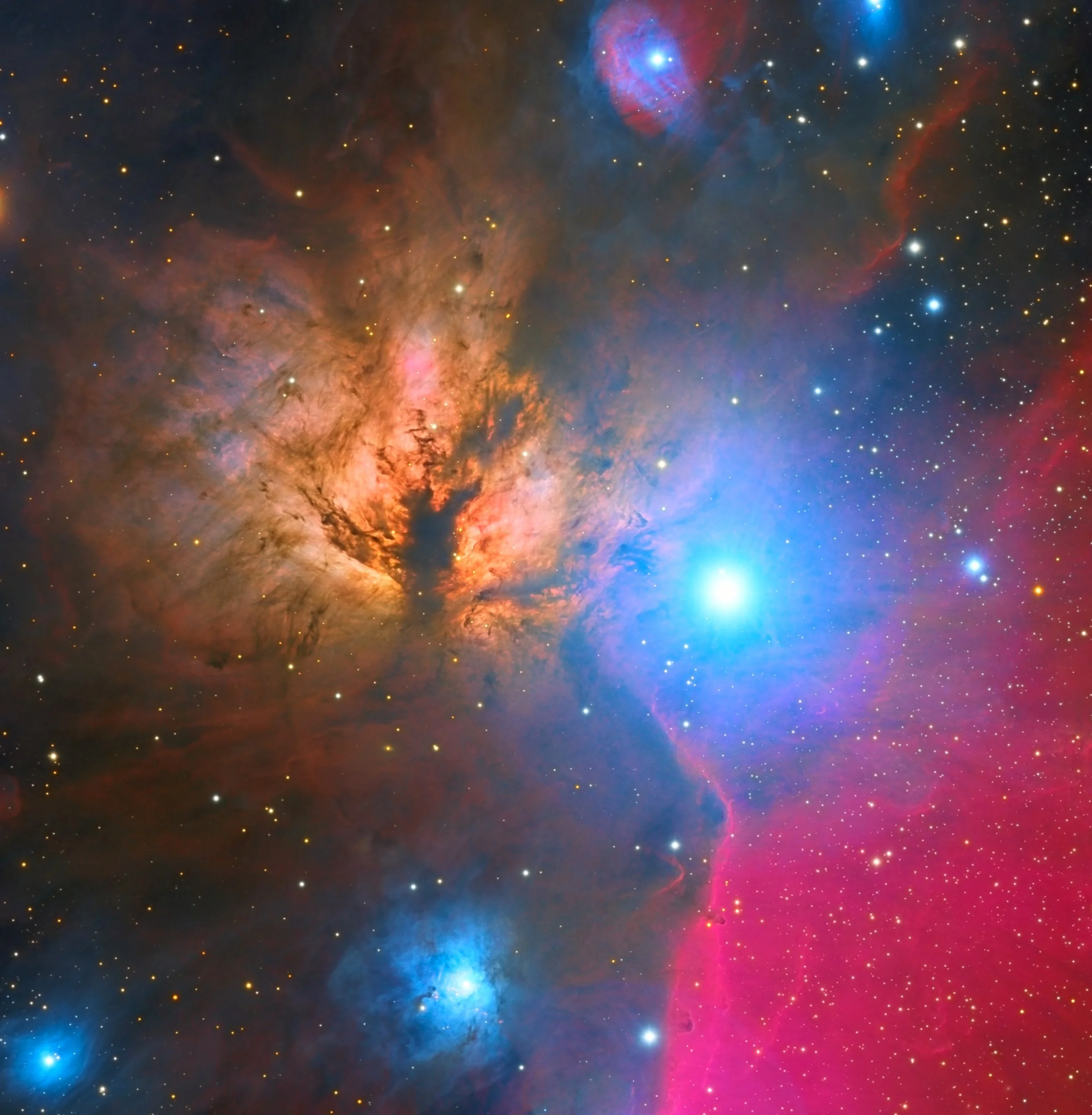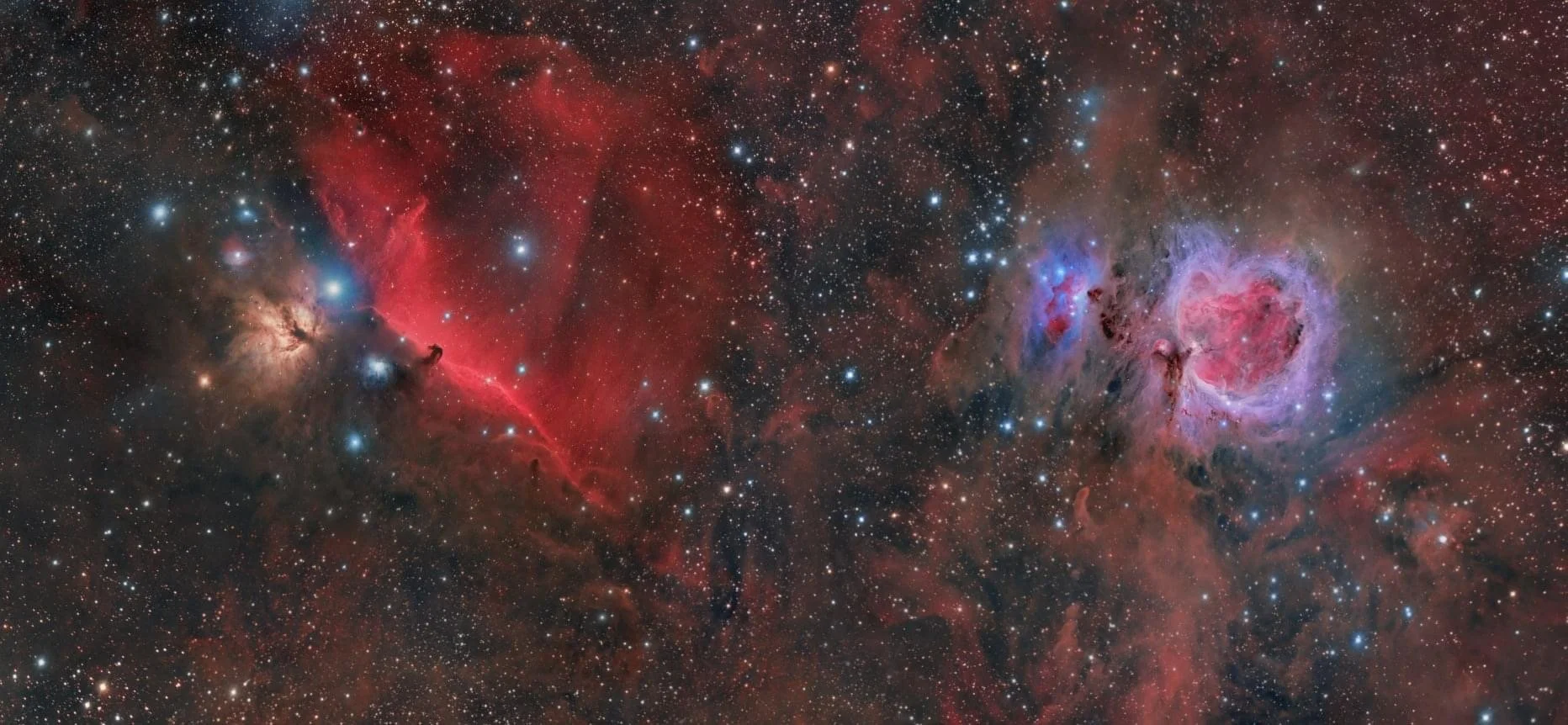
AAPOD2 Image Archives
NGC 2024 - Flame Nebula
Image Description and Details : NGC 2024, also known as the Flame Nebula, this nebula is located in the Orion constellation, although we can also see part of the IC 434 nebular complex and some objects such as NGC 2023 just below or IC 435 in the lower left corner. The choice of this frame is intended to see this nebula as a burning tree lying on a field of hydrogen and dust, but if we look closely we can see that there are several layers of gas and dust shaping this nebula. The star that floods the image with light is Alnitak, the easternmost star in Orion's belt, only 1400 light years away from us.
Equipment:
Telescope TEC 180FL - Camera SBIG STXL-16200
Mount Paramount ME II
Filter set Astrodon LRGB Tru-Balance E-Series Gen 2 50mm.
Accessories:
Starizona Microtouch Autofocuser, Feathertouch Motorized Focuser, SBIG filter wheel STXL-FW8G, Drew buster controler.
Data:
H-Alpha: 21x1800" -20C bin 1x1
Luminance: 48x300" -20C bin 1x1
Blue: 32x600" -20C bin 1x1
Green: 17x600" -20C bin 1x1
Red: 19x600" -20C bin 1x1
Total integration time: 25,8horas.
Copyright: Alberto Pisabarro, Jim & Linda Powell
Orion Constellation & Barnard loop
Image Description and Details :
Here is my post on this Orion photo and the Barnard loop, I spent the only clear night without a moon to try the samyang 135mm f2, because I wanted to have fun doing astrophotography. I absolutely wanted to shoot the constellation of Orion and the loop of Barnard. It was complicated to image it with a more than hazardous seeing but on 210 shots of 120 seconds I kept only 100 raw. After processing tests, I was happy with my final treatment.
Samyang 135mm at f2.8Canon 6D Iso 1600 Photomax Heq5 pro100 brutes x 120''Copyright: Oliver Globetrotter & P. Bernhard
IC434 Horsehead nebula
Image Description and Details :
Tak FSQ-106ED F/5SBIG STF-8300M + QHY CFW3 Filter wheelAstrodon L Channel 180sec x 116, 1binAstrodon H-a, R, G,B each Channel 300sec x 50, 1binBias, Dark, Flat processedOrion CT80 + ZWO ASI 120miniFLI Atlas focuserSkywatcher EQ8 mount (with EQ Drive standard4 TCS)
Copyright: Kim Young Dae
The outpost
Image Description:
On a rocky summit of an icy planet sits a remote research outpost. This frozen world orbits a inconspicuous star in a minor arm of a giant barred spiral galaxy.
Named after a mythical creature of an ancient culture that once dominated the planet, this scientific outpost is called the Sphinx. The Spinx is mythicized to have mercilessly killed those who couldn't answer her riddle.
The Sphinx station has a prime view on one of the galaxies major star forming regions, named after another mythological figure, a giant hunter. Not all scientific riddles within the hunter are solved yet, but fortunately the Sphinx hasn't killed any scientists so far.
The thin atmosphere of the planet at this high altitude location contains enough water to form clouds, which shroud the observatory in freezing fog about 40% of the time. If the clouds part, the hunter's giant molecular clouds of ionized hydrogen are lighting up the sky.
I had the opportunity to visit the Sphinx outpost with benjaminbarakat in September for a night of astrophotography. After a sternous night, we were happy that both the planet and the mythical creatures had shown mercy. The hunter had made its appearance and we escaped this stunning place without getting killed by lack of oxygen, the cold or the wrath of the Sphinx.
EXIF
Canon EOS EOS Ra
Canon 24-70mm f/2.8 L ll @ 50mm
iOptron SkyTracker Pro
Sky:
4 panel panorama, each a stack of 7 x 60s @ ISO1600
Foreground:
Panorama of 4x 2s @ ISO400 during blue hour
Copyright: Ralf Rohner
M42 Widefield
2 panel mosaic crop
C 8 Hyperstar
C 14 Hyperstar
Starlight Xpress M25 C
Starlight Xpress 694 C
QHY 247 C
Baader L Booster Filter
Copyright: JP Pecorino
Barnard 33
HorseHead Nebula
38 X 480 seconds
C 8 Hyperstar
SX M 25C
Baader L Booster filter
Copyright: JP Pecorino
Horsehead and a Flame
The Horsehead is one of the most famous nebulae on the sky. The horse-head feature is dark because it is really an opaque dust cloud that lies in front of the bright emission nebula. Like clouds in Earth's atmosphere, this cosmic cloud has assumed a recognizable shape by chance. After many thousands of years, the internal motions of the cloud will surely alter its appearance. The emission nebula's color is caused by electrons recombining with protons to form hydrogen atoms. On the image left is the Flame Nebula that also contains filaments of dark dust. Just to the lower left of the Horsehead nebula is a blueish reflection nebulae that preferentially reflects the blue light from nearby stars.
Tech card:
Imaging telescope: Explore Scientific 127mm ED TRIPLET APO.
Imaging camera: ZWO ASI294MM-Pro.
Mounts: iOptron CEM60.
Guiding camera: ZWO ASI290MM mini.
Focal reducer: Explore Scientific 0.7 Reducer/Flattener.
Accessory: ZWO OAG · ZWO ASIAIR Pro · ZWO 8x 1.25" Filter Wheel (EFW).
Frames:
Chroma 3nm Ha: 12x600" (2h) (gain: 200.00) -20C bin 1x1.
Chroma 3nm OIII: 15x600" (2h 30') (gain: 200.00) -20C bin 1x1.
Chroma 3nm SII: 8x600" (1h 20') (gain: 200.00) -20C bin 1x1.
Total integration: 5h 50'
Darks: ~50.
Flats: ~30.
Flat darks: ~30.
Avg. Moon age: 19.61 days.
Avg. Moon phase: 75.53%
Bortle Dark-Sky Scale: 4.00.
RA center: 5h 41' 15"
DEC center: -2° 16' 1"
Pixel scale: 0.706 arcsec/pixel.
Orientation: -93.427 degrees.
Field radius: 0.983 degrees.
Imaging dates: Jan. 3 and 4, 2021.
Imaging location: Abu Dhabi desert, UAE.
Copyright: Wissam Ayoub
Ngc 2024 Flame Nebula
Image Description and Details : Flame Nebula (Ngc 2024) made by Team ARO in South Portugal . This Team is composed of Francis Bozon, Jean_Luc Gangloff, Stéphane Gueyraud.The Flame Nebula extends over about 12 light years. Alnitak (Zeta Orionis), the easternmost bright star in Orion's belt, energises the nebula. The intense ultraviolet radiation from this blue supergiant ionises the hydrogen atoms in the nebula.Gas and especially dust in front of NGC 2024 absorb the light from the nebula and form the dark ribbon seen in the visible light images.These acquisitions were made with Scope Fsq 106, on Eq6 Pro and ZWO Asi 1600MM camera. The exposure times are as follows:-Ha= 201 x 180''-R = 73 x 150 ''-V = 92 x 120 ''-B= 94 x 120 ''That is a total time of about 19.15 hours.
Copyright: Francis Bozon / Team Aro
Orion CoNstellation
Date image was taken: 1/5/2020
Image Title: Orion Costellation
Image Description and Details : Orion Costellation
Sharpstar Optics 76EDPH Artesky
Qhyccd 600 Mono
Filter Optolong Astronomy Filter Narrowband improved version
44 light 600 sec HA
44 Light 300 sec Red
33 Light 300 sec Green
22 Light 300 sec Blu
Software APT - Astro Photography ToolPixinsight Photoshop
Copyright: Andrea Maggi
The Great Orion-Nebula, the Horsehead- & Flame Nebula and M78
In this capture you can find the emission nebula (M42), a combination of emission and reflection nebula (IC434) and the reflection nebula (M78). Other objects can be found in addition to the three main actors in the photograph. Down under the capture details I named all objects in the field I am familiar with.
This picture shows emission nebula (M42), a combination of emission and reflection nebula (ic434) and a pure reflection nebula (M 78).
List of objects:
M42, NGC1975 (Running Man), NGC1981, NGC1999, IC430, Orion AD N Complex, IC434, NGC2024, NGC2023, IC432, NGC1990, CR70, M78, NGC2071
Stars:
Alnitak, Alnilam and Mintaka
Tech.Details:
Scope: William Optics Spacecat 51
Cam: Nikon D810 Astrocool
Filter: Hutechidas Lps D1
Exif.: 55 x300" ISO 1600
Image Copyright: JN-Astrophotography











